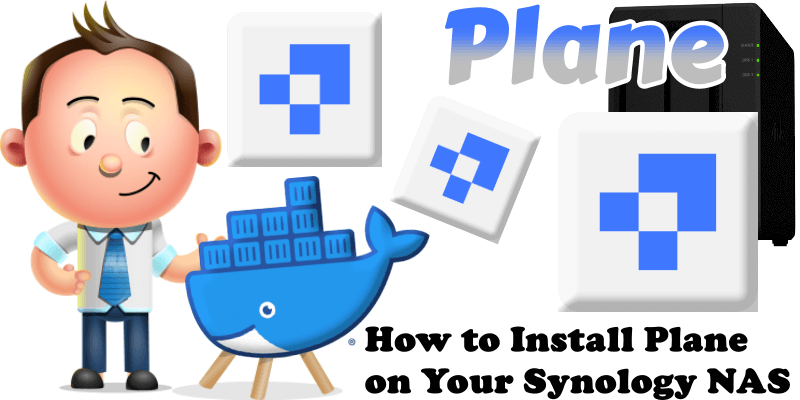
Plane is an open-source software development tool to manage issues, sprints, and product roadmaps with peace of mind. It allows users to start with a basic task tracking tool and gradually adopt various project management frameworks like Agile, Waterfall, and many more. In this step by step guide I will show you how to install Plane on your Synology NAS using Docker & Portainer.
STEP 1
Please Support My work by Making a Donation.
STEP 2
Install Portainer using my step by step guide. If you already have Portainer installed on your Synology NAS, skip this STEP. Attention: Make sure you have installed the latest Portainer version.
STEP 3
Make sure you have a synology.me Wildcard Certificate. Follow my guide to get a Wildcard Certificate. If you already have a synology.me Wildcard certificate, skip this STEP.
STEP 4
Go to Control Panel / Login Portal / Advanced Tab / click Reverse Proxy. Follow the instructions in the image below.
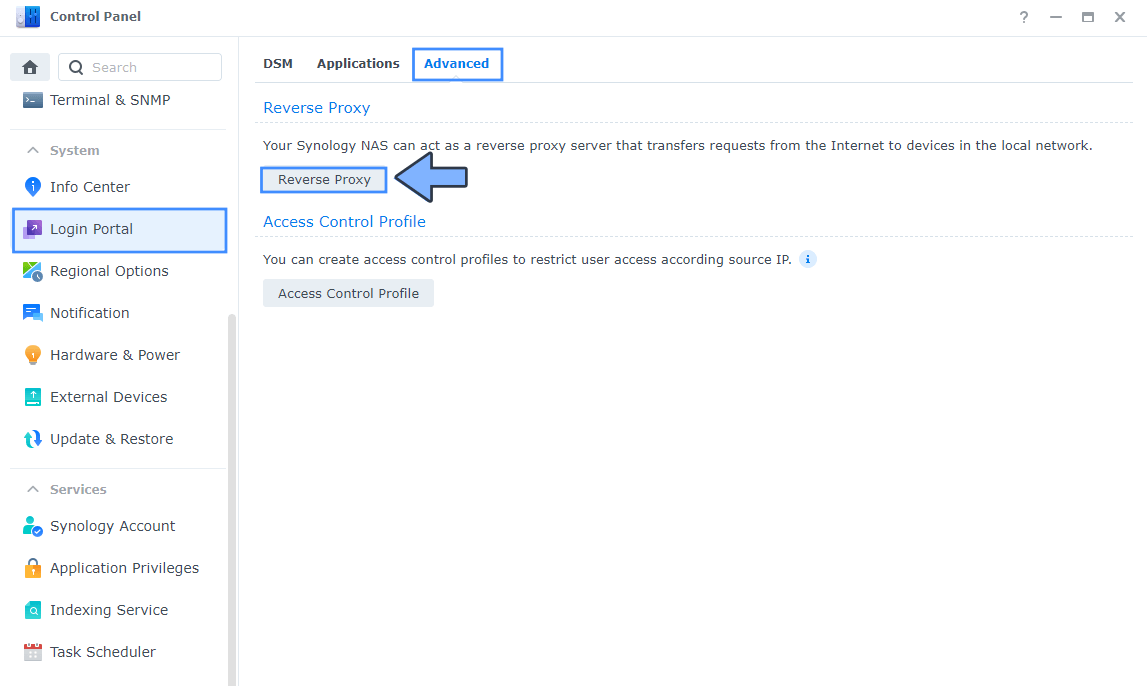
STEP 5
Now click the “Create” button. Follow the instructions in the image below.
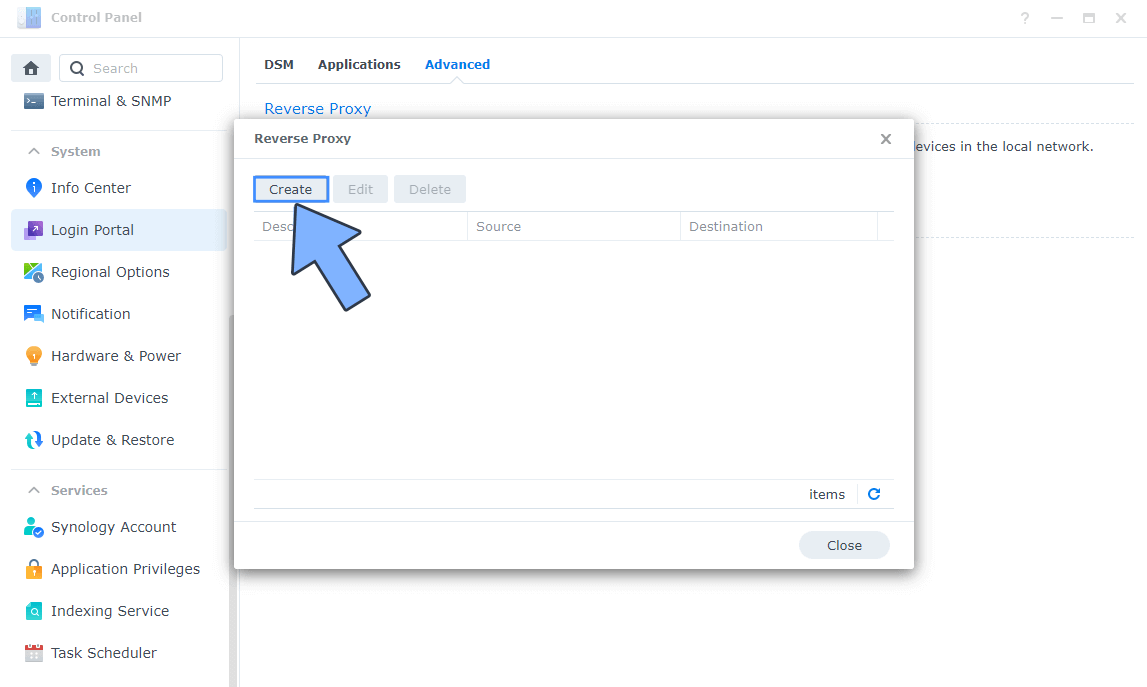
STEP 6
After you click the Create button, the window below will open. Follow the instructions in the image below.
On the General area, set the Reverse Proxy Name description: type in Plane. After that, add the following instructions:
Source:
Protocol: HTTPS
Hostname: plane.yourname.synology.me
Port: 443
Check Enable HSTS
Destination:
Protocol: HTTP
Hostname: localhost
Port: 3356

STEP 7
On the Reverse Proxy Rules click the Custom Header tab. Click Create and then, from the drop-down menu, click WebSocket. After you click on WebSocket, two Header Names and two Values will be automatically added. Click Save. Follow the instructions in the image below.
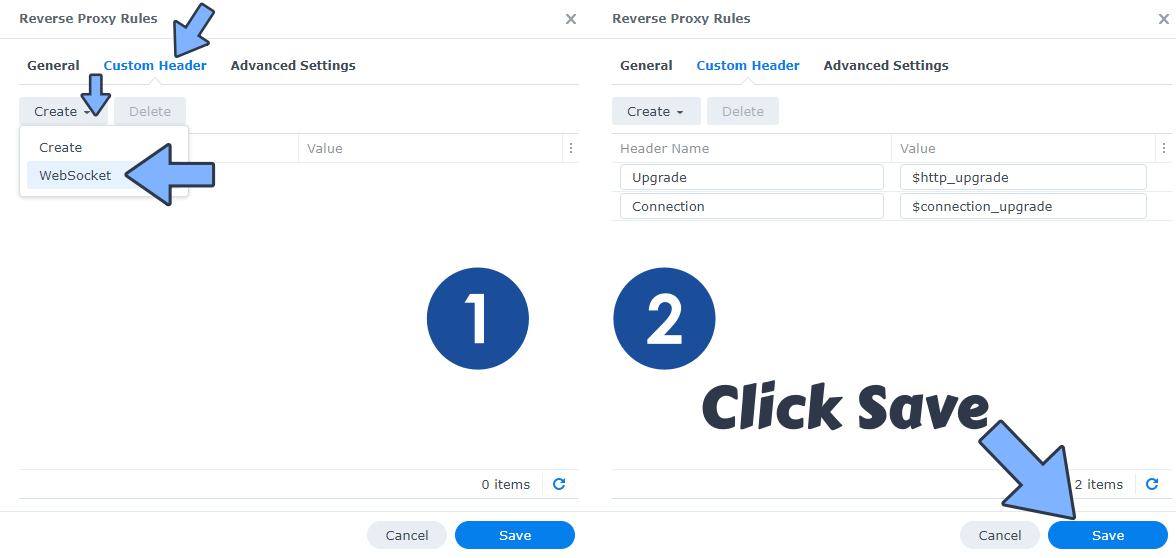
STEP 8
Go to Control Panel / Network / Connectivity tab/ Check Enable HTTP/2 then click Apply. Follow the instructions in the image below.
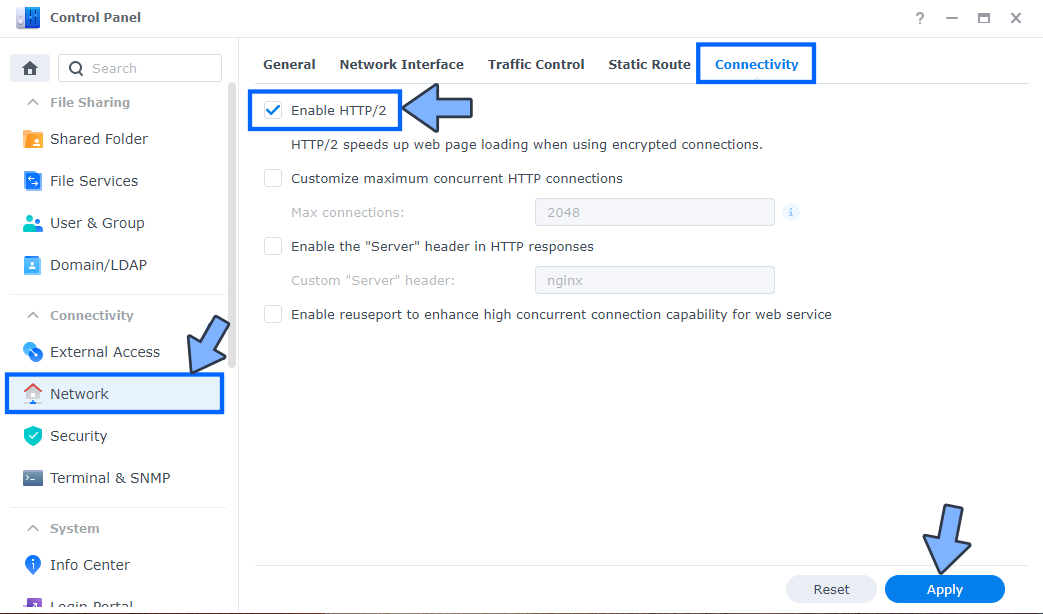
STEP 9
Go to Control Panel / Security / Advanced tab/ Check Enable HTTP Compression then click Apply. Follow the instructions in the image below.
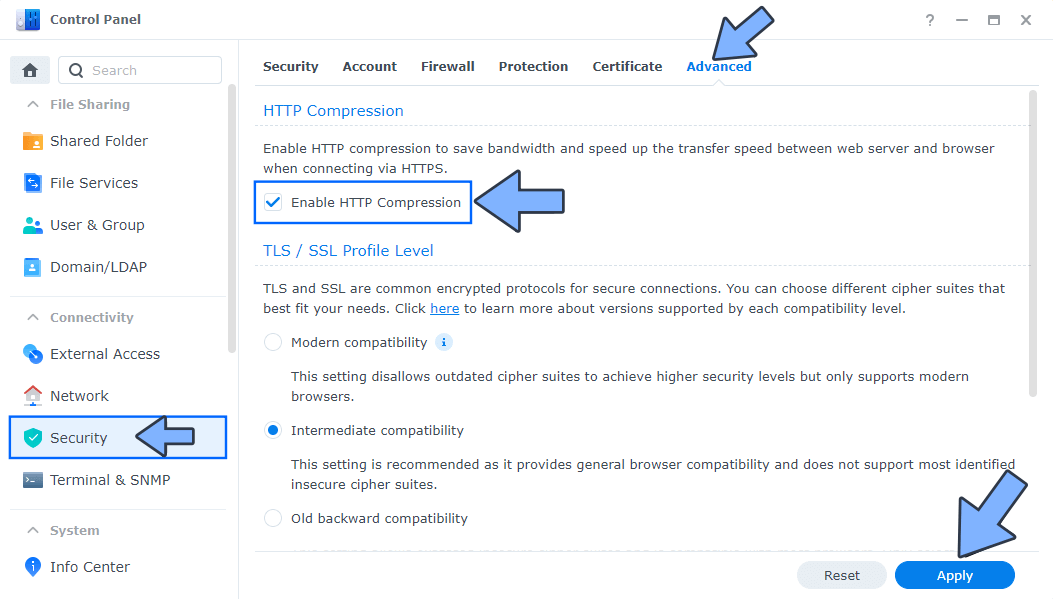
STEP 10
Go to File Station and open the docker folder. Inside the docker folder, create one new folder and name it plane. Follow the instructions in the image below.
Note: Be careful to enter only lowercase, not uppercase letters.
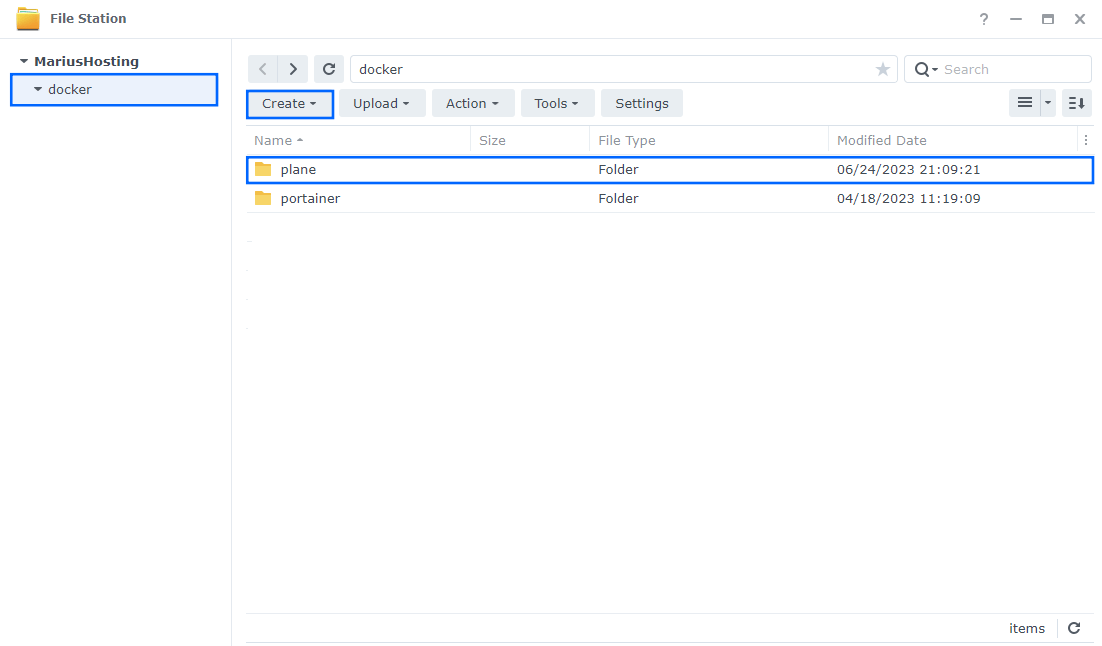
STEP 11
Now create four new folders inside the plane folder that you created at STEP 10 and name them db, rabbitmq, redis, uploads. Follow the instructions in the image below.
Note: Be careful to enter only lowercase, not uppercase letters.

STEP 12
Log into Portainer using your username and password. On the left sidebar in Portainer, click on Stacks then + Add stack. Follow the instructions in the image below.
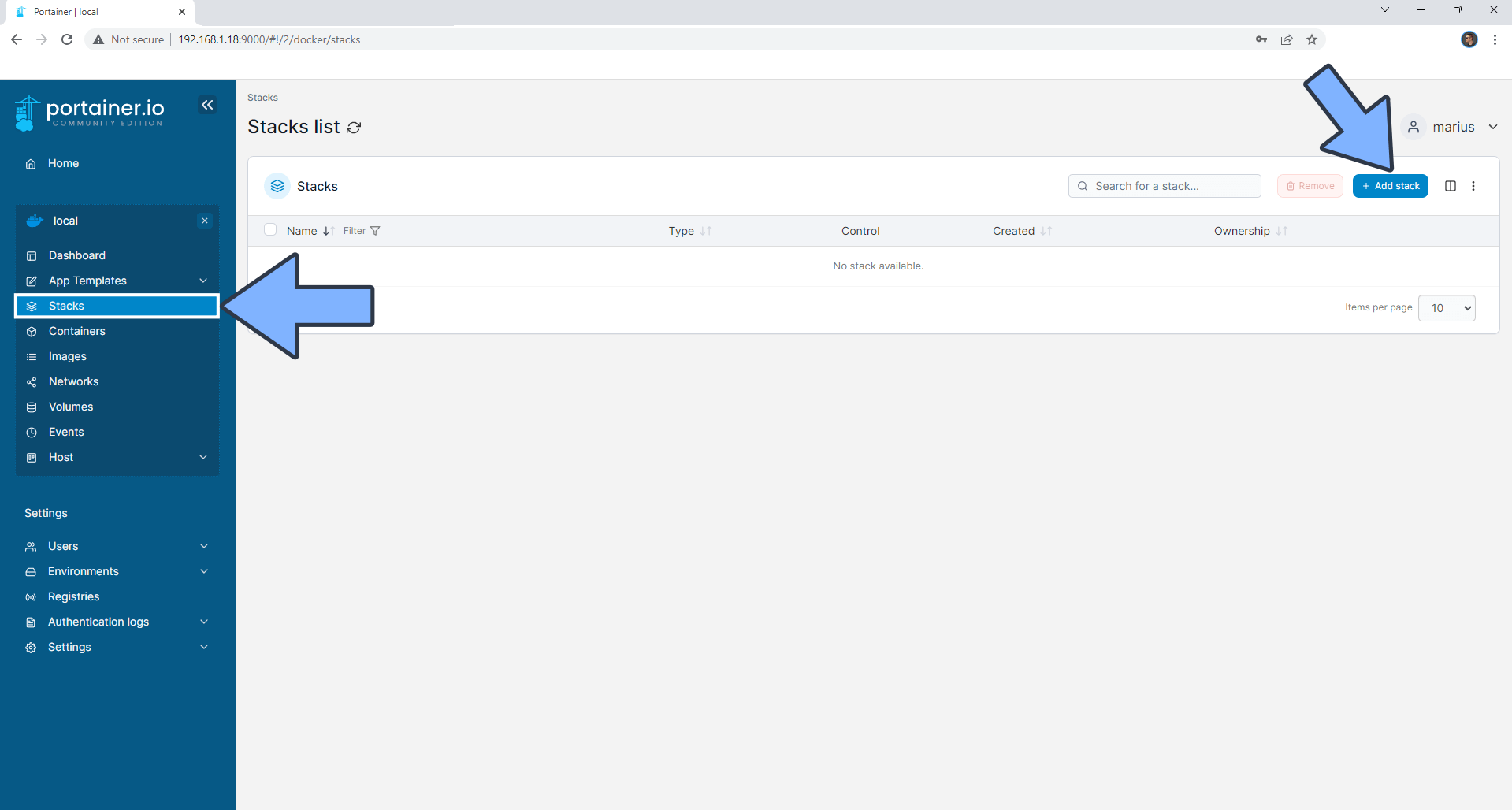
STEP 13
In the Name field type in plane. Follow the instructions in the image below.
services:
redis:
image: redis:7
container_name: Plane-REDIS
hostname: plane-redis
mem_limit: 256m
mem_reservation: 50m
cpu_shares: 768
security_opt:
- no-new-privileges:true
read_only: true
user: 1026:100
healthcheck:
test: ["CMD-SHELL", "redis-cli ping || exit 1"]
volumes:
- /volume1/docker/plane/redis:/data:rw
environment:
TZ: Europe/Bucharest
restart: on-failure:5
db:
image: postgres:17
command: postgres -c 'max_connections=1000'
container_name: Plane-DB
hostname: plane-db
mem_limit: 1g
cpu_shares: 768
security_opt:
- no-new-privileges:true
healthcheck:
test: ["CMD", "pg_isready", "-q", "-d", "plane", "-U", "planeuser"]
timeout: 45s
interval: 10s
retries: 10
volumes:
- /volume1/docker/plane/db:/var/lib/postgresql/data:rw
environment:
POSTGRES_DB: plane
POSTGRES_USER: planeuser
POSTGRES_PASSWORD: planepass
restart: on-failure:5
plane-mq:
image: rabbitmq:3.13.6-management-alpine
container_name: Plane-RABBITMQ
restart: on-failure:5
volumes:
- /volume1/docker/plane/rabbitmq:/var/lib/rabbitmq:rw
environment:
RABBITMQ_HOST: plane-mq
RABBITMQ_PORT: 5672
RABBITMQ_DEFAULT_USER: plane
RABBITMQ_DEFAULT_PASS: plane
RABBITMQ_DEFAULT_VHOST: plane
RABBITMQ_VHOST: plane
AMQP_URL: amqp://plane:plane@plane-mq:5672/plane
minio:
image: minio/minio:latest
command: server /export --console-address ":9090"
container_name: Plane-MINIO
hostname: plane-minio
mem_limit: 6g
cpu_shares: 768
security_opt:
- no-new-privileges:true
user: 1026:100
healthcheck:
test: ["CMD", "mc", "ready", "local"]
interval: 5s
timeout: 5s
retries: 5
volumes:
- /volume1/docker/plane/uploads:/export:rw
environment:
MINIO_ROOT_USER: ${AWS_ACCESS_KEY_ID}
MINIO_ROOT_PASSWORD: ${AWS_SECRET_ACCESS_KEY}
restart: on-failure:5
back:
image: makeplane/plane-backend:stable
command: ./bin/docker-entrypoint-api.sh
container_name: Plane-BACK
hostname: api
mem_limit: 6g
cpu_shares: 768
security_opt:
- no-new-privileges:true
user: 1026:100
healthcheck:
test: wget --no-verbose --tries=1 --spider http://api:8000
env_file:
- stack.env
restart: on-failure:5
depends_on:
redis:
condition: service_healthy
db:
condition: service_healthy
worker:
image: makeplane/plane-backend:stable
command: ./bin/docker-entrypoint-worker.sh
container_name: Plane-WORKER
hostname: worker
mem_limit: 6g
cpu_shares: 768
security_opt:
- no-new-privileges:true
user: 1026:100
env_file:
- stack.env
restart: on-failure:5
depends_on:
redis:
condition: service_healthy
db:
condition: service_healthy
back:
condition: service_started
plane-mq:
condition: service_started
beat:
image: makeplane/plane-backend:stable
command: ./bin/docker-entrypoint-beat.sh
container_name: Plane-BEAT
hostname: beat-worker
mem_limit: 6g
cpu_shares: 768
security_opt:
- no-new-privileges:true
user: 1026:100
env_file:
- stack.env
restart: on-failure:5
depends_on:
redis:
condition: service_healthy
db:
condition: service_healthy
back:
condition: service_started
plane-mq:
condition: service_started
migrator:
image: makeplane/plane-backend:stable
container_name: Plane-MIGRATOR
restart: no
env_file:
- stack.env
command: ./bin/docker-entrypoint-migrator.sh
depends_on:
db:
condition: service_healthy
redis:
condition: service_healthy
plane-mq:
condition: service_started
front:
image: makeplane/plane-frontend:stable
command: node web/server.js web
container_name: Plane-FRONT
hostname: web
mem_limit: 6g
cpu_shares: 768
security_opt:
- no-new-privileges:true
user: 1026:100
healthcheck:
test: wget --no-verbose --tries=1 --spider http://web:3000
env_file:
- stack.env
restart: on-failure:5
depends_on:
back:
condition: service_started
worker:
condition: service_started
space:
image: makeplane/plane-space:stable
command: node space/server.js space
container_name: Plane-SPACE
hostname: plane-space
mem_limit: 2g
cpu_shares: 768
security_opt:
- no-new-privileges:true
user: 1026:100
env_file:
- stack.env
restart: on-failure:5
depends_on:
back:
condition: service_started
worker:
condition: service_started
front:
condition: service_healthy
admin:
image: makeplane/plane-admin:stable
container_name: Plane-ADMIN
command: node admin/server.js admin
restart: on-failure:5
depends_on:
- back
- front
live:
image: makeplane/plane-live:stable
container_name: Plane-LIVE
restart: on-failure:5
command: node live/dist/server.js live
depends_on:
- back
- front
proxy:
image: makeplane/plane-proxy:stable
container_name: Plane-PROXY
hostname: planeproxy
mem_limit: 1g
cpu_shares: 768
security_opt:
- no-new-privileges:true
ports:
- 3356:80
env_file:
- stack.env
environment:
FILE_SIZE_LIMIT: ${FILE_SIZE_LIMIT}
BUCKET_NAME: ${AWS_S3_BUCKET_NAME}
depends_on:
back:
condition: service_started
front:
condition: service_healthy
space:
condition: service_started
Note: Before you paste the code above in the Web editor area below, change the value numbers for user with your own UID and GID values. (Follow my step by step guide on how to do this.) 1026 is my personal UID value and 100 is my personal GID value. You have to type in your own values.
Note: Before you paste the code above in the Web editor area below, change the value for TZ. (Select your current Time Zone from this list.)
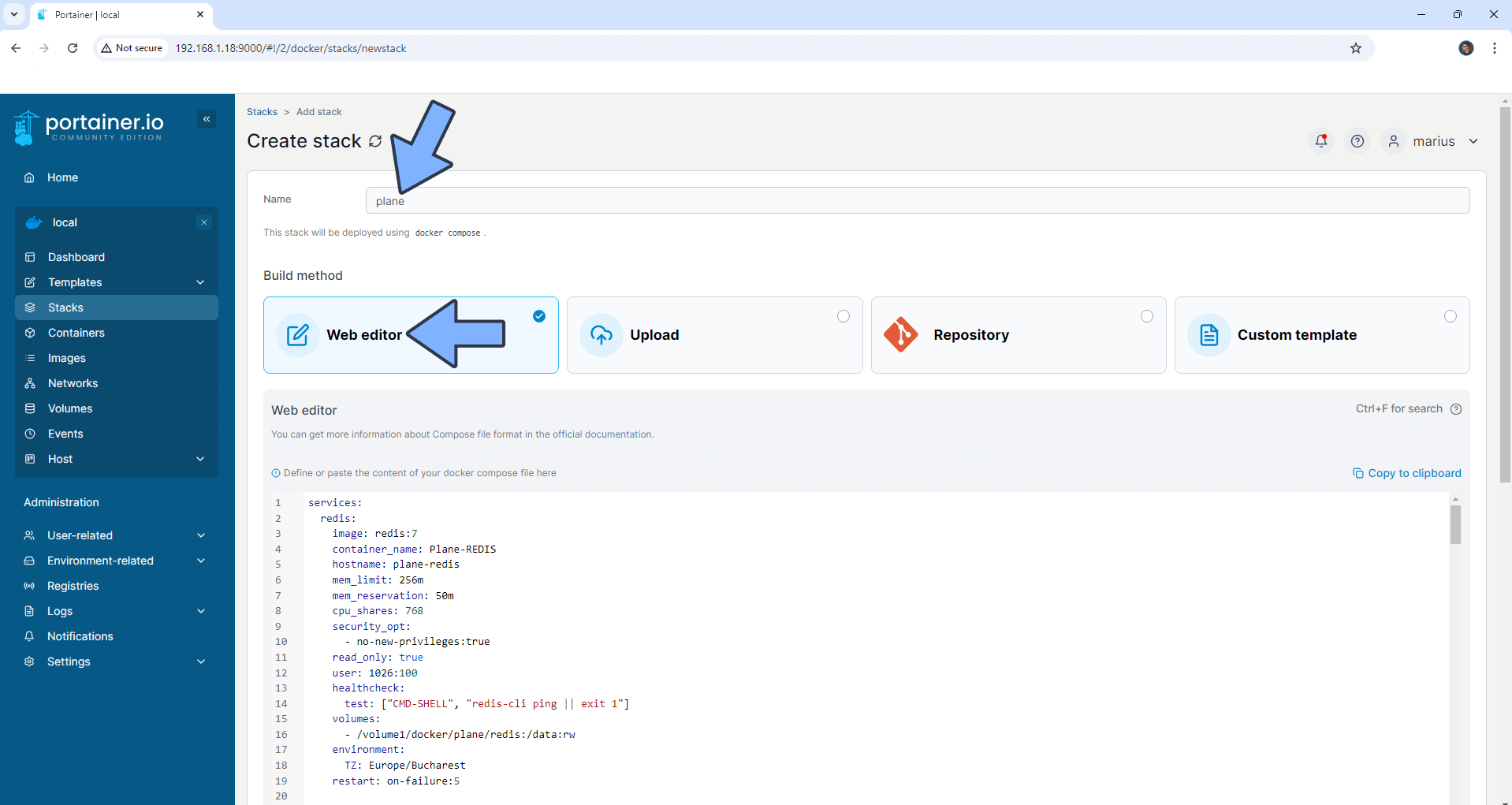
STEP 14
Click the Upload button after Web editor. Download the stack.env file by clicking the blue link below and then upload it from your computer in the “Load variables from .env files“. Follow the instructions in the image below. 🔒Note: Support my work to unlock the password. You can use this password to download any file on mariushosting forever!
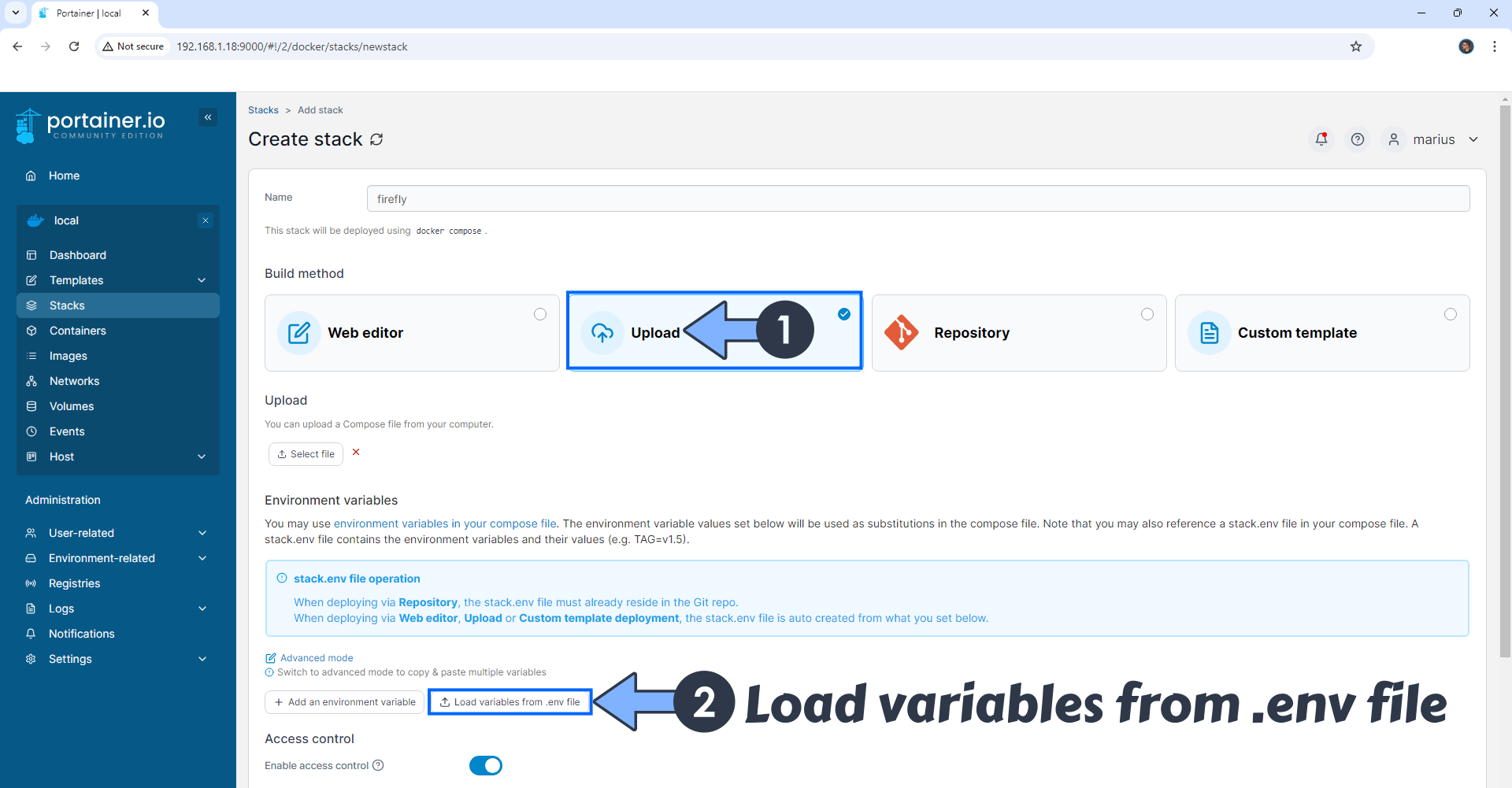
STEP 15
Note: On the Environment variables change the value for WEB_URL. Type in your own synology.me DDNS that you have previously created at STEP 6 with https at the beginning. 🟢
Note: On the Environment variables change the value for CORS_ALLOWED_ORIGINS. Type in your own synology.me DDNS that you have previously created at STEP 6 with https at the beginning. 🟢 ⚠️Warning: Do not change any of the other values. All the values should be inside ” “.
Note: On the Environment variables change the value for SECRET_KEY. (Generate your own 32 length SECRET_KEY.)
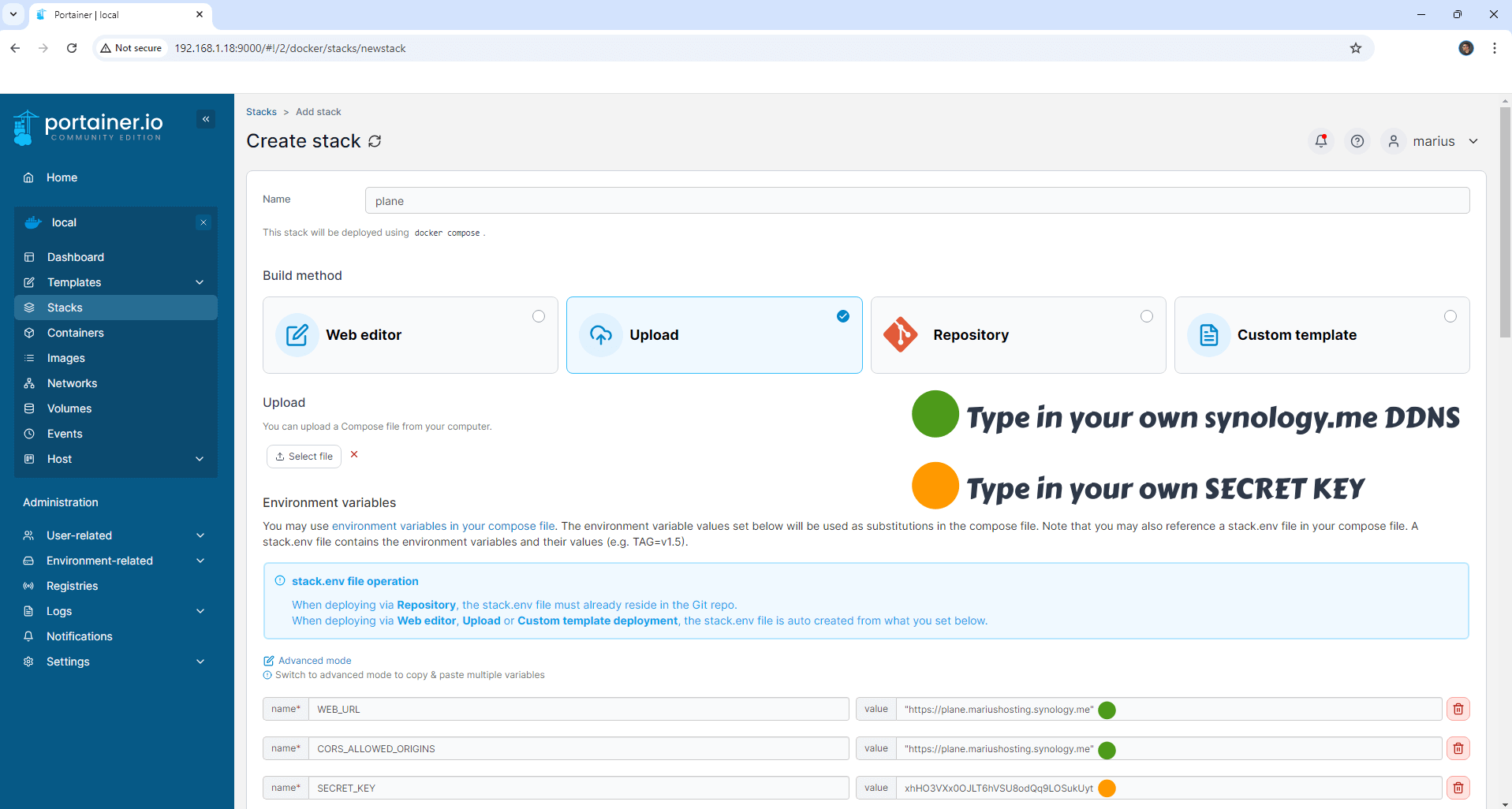
STEP 16
After you make the changes, click the Web editor button. Follow the instructions in the image below.
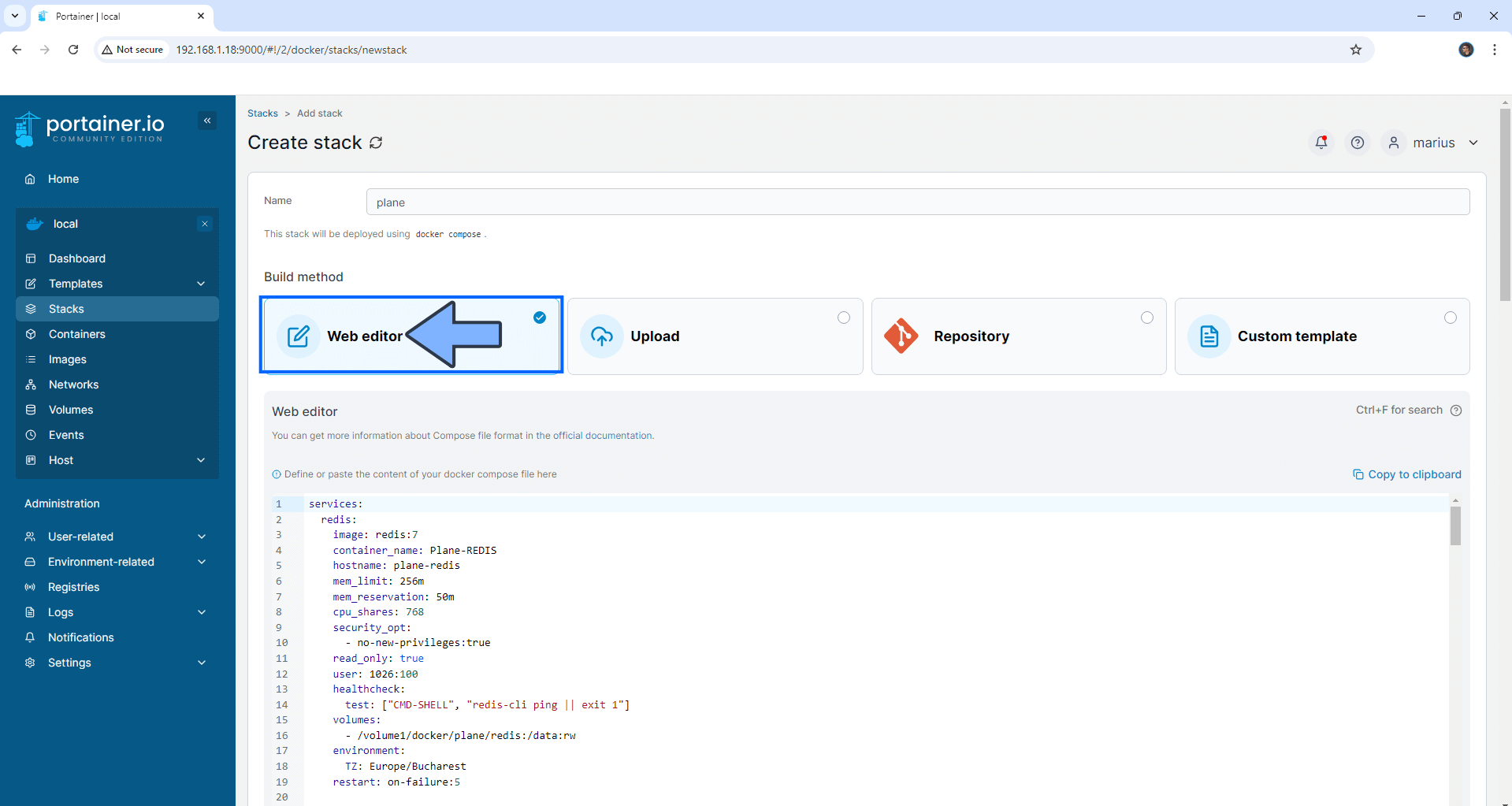
STEP 17
Scroll down on the page until you see a button named Deploy the stack. Click on it. Follow the instructions in the image below. The installation process can take up to a few minutes. It will depend on your Internet speed connection.
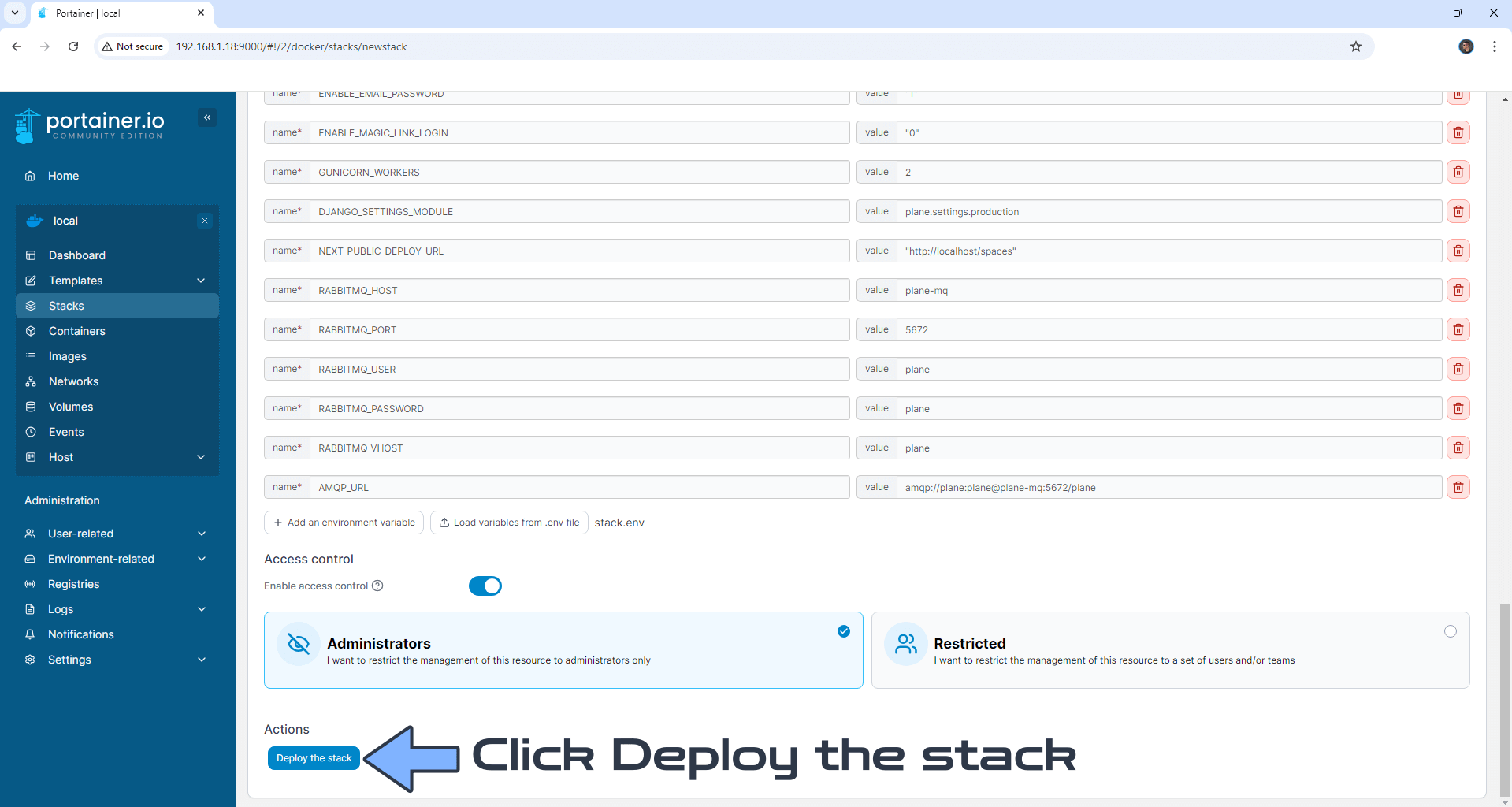
STEP 18
If everything goes right, you will see the following message at the top right of your screen: “Success Stack successfully deployed“.

STEP 19
Your Plane-MIGRATOR container will be marked as exited – code 0. You don’t have to do anything. Go straight to STEP 20.
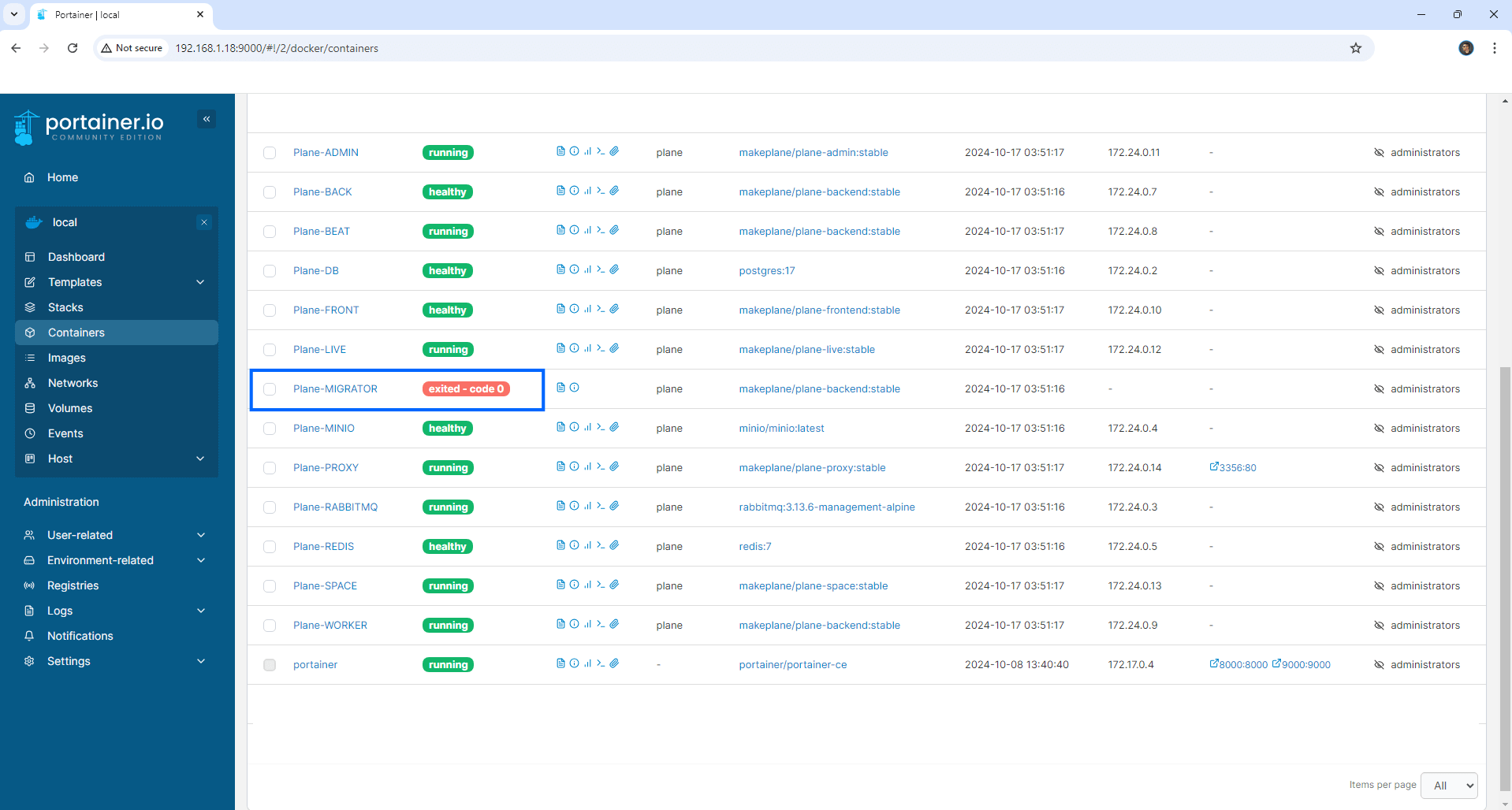
STEP 20
Go back to STEP 1 or you will deal with karma 🙂.
STEP 21
Now open your browser and type in your HTTPS/SSL certificate like this https://plane.yourname.synology.me/god-mode – In my case it’s https://plane.mariushosting.synology.me/god-mode If everything goes right, you will see the Plane Admin page. Type in your own info, then Click Continue. Follow the instructions in the image below. Note: Don’t forget to add /god-mode at the end of your synology.me DDNS.
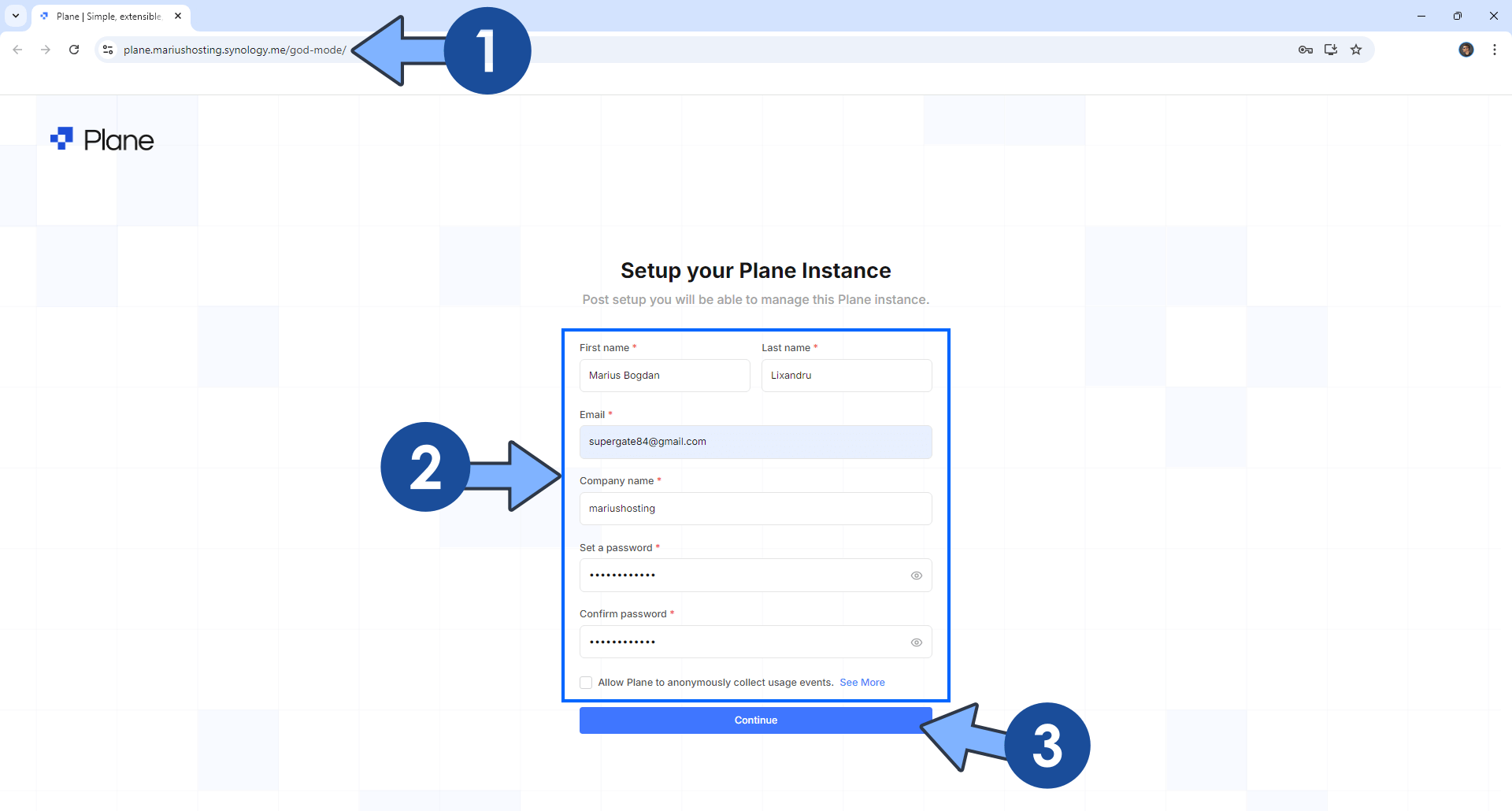
STEP 22
In this section you can set up your SMTP email and other details. Follow the instructions on how to set up email notifications on Plane.
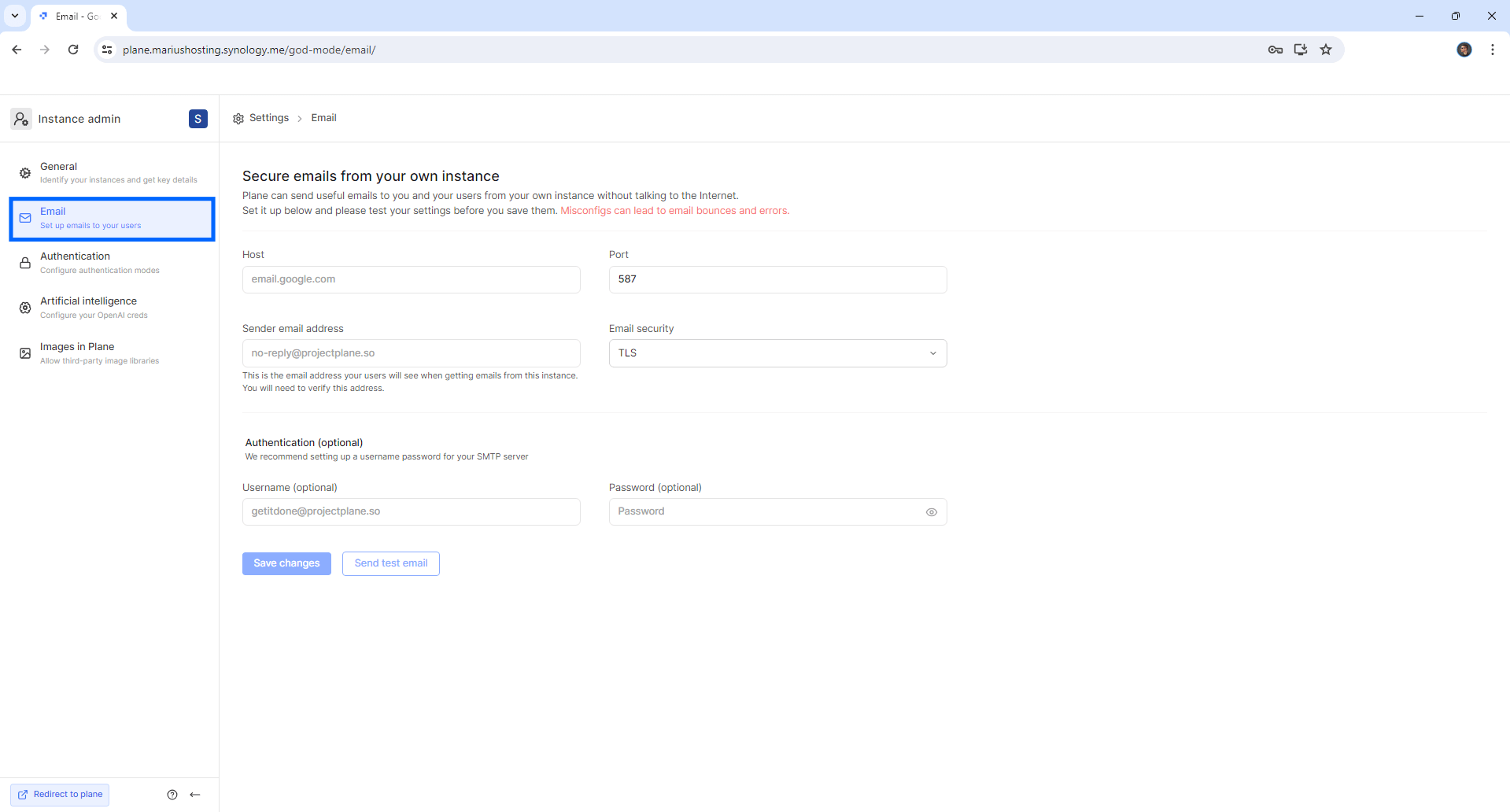
STEP 23
Now open your browser and type in your HTTPS/SSL certificate like this https://plane.yourname.synology.me – In my case it’s https://plane.mariushosting.synology.me Type in your Email address, then click Continue. Follow the instructions in the image below.
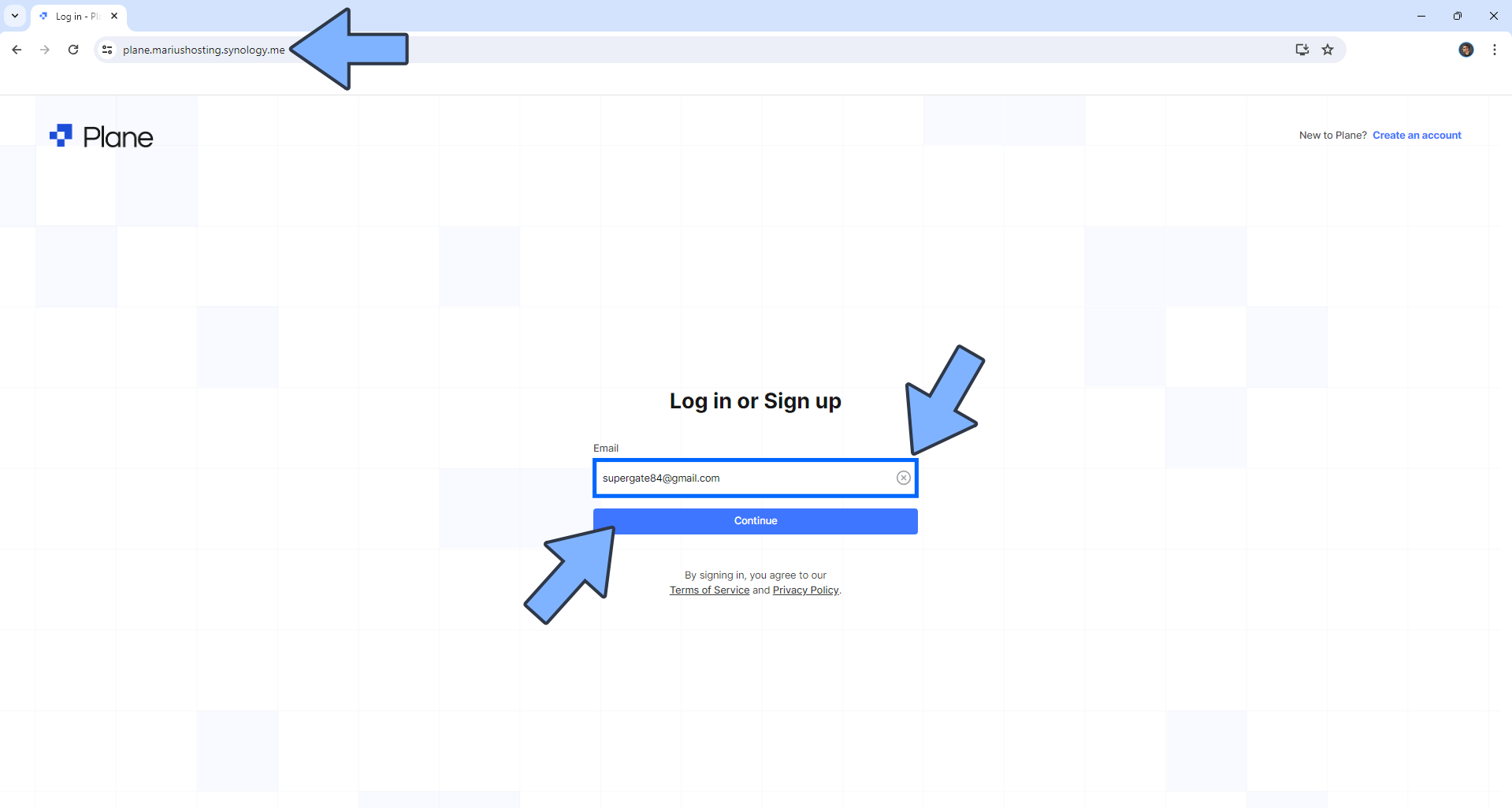
STEP 24
Type in your own Password, then click Go to workspace. Follow the instructions in the image below.

STEP 25
Type in your own info, then click Continue. Follow the instructions in the image below.
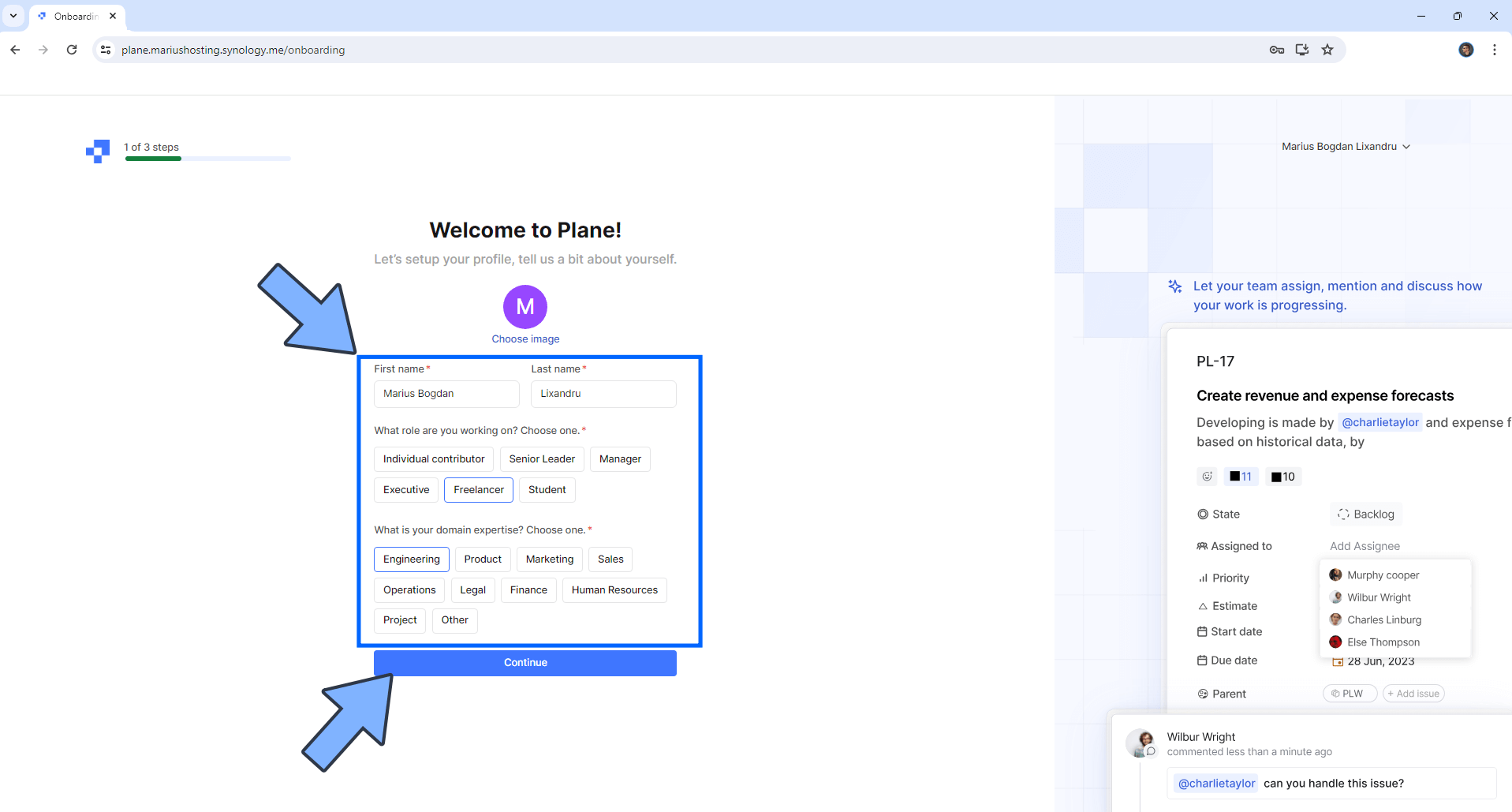
STEP 26
Type in your Workspace name and the Company size, then click Create Workspace. Follow the instructions in the image below.
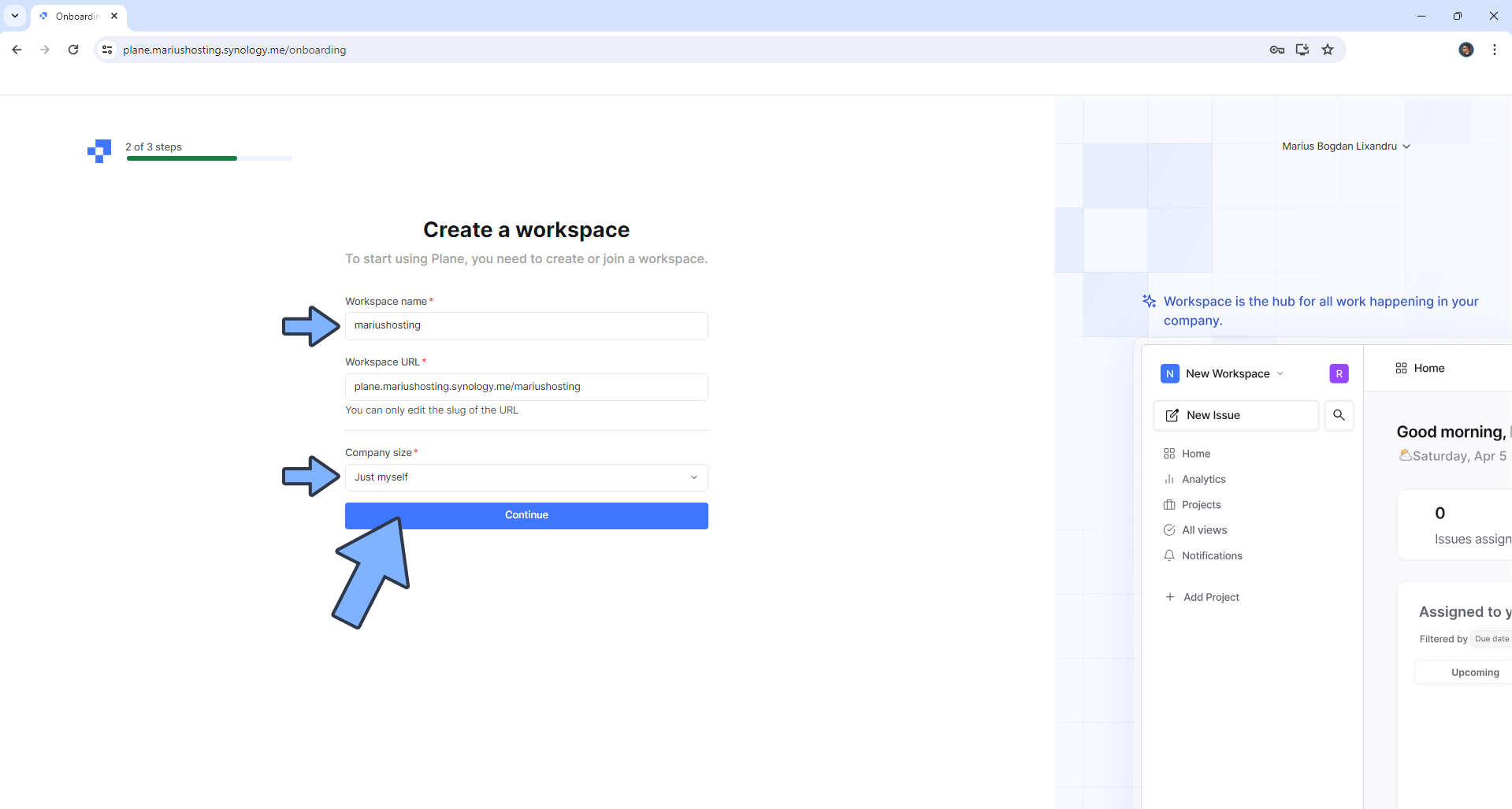
STEP 27
Invite your team to work with you. Click I’ll do it later to set it up later. Follow the instructions in the image below.
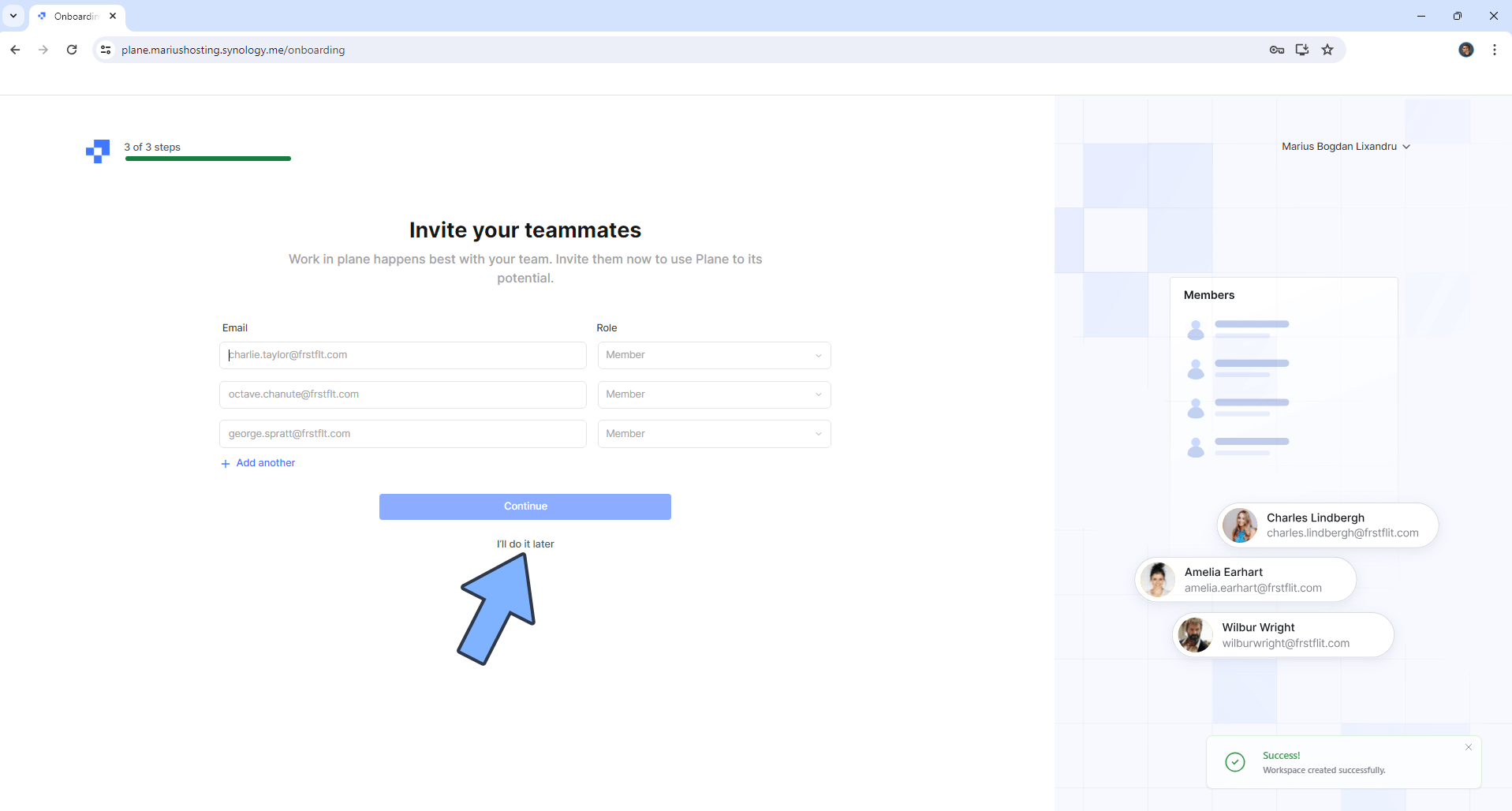
STEP 28
Close the pop-up window. Follow the instructions in the image below.
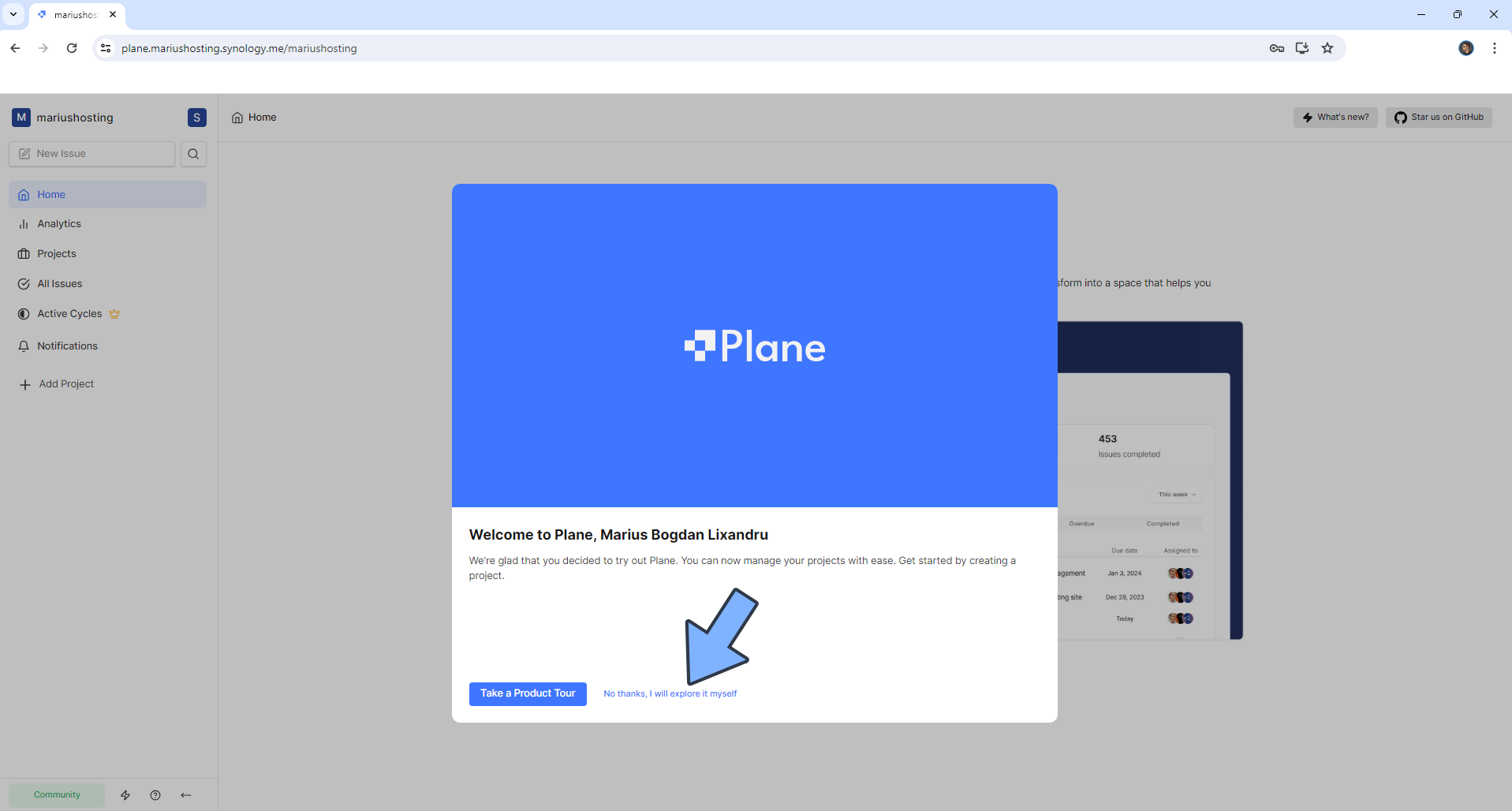
STEP 29
Your Plane dashboard at a glance!
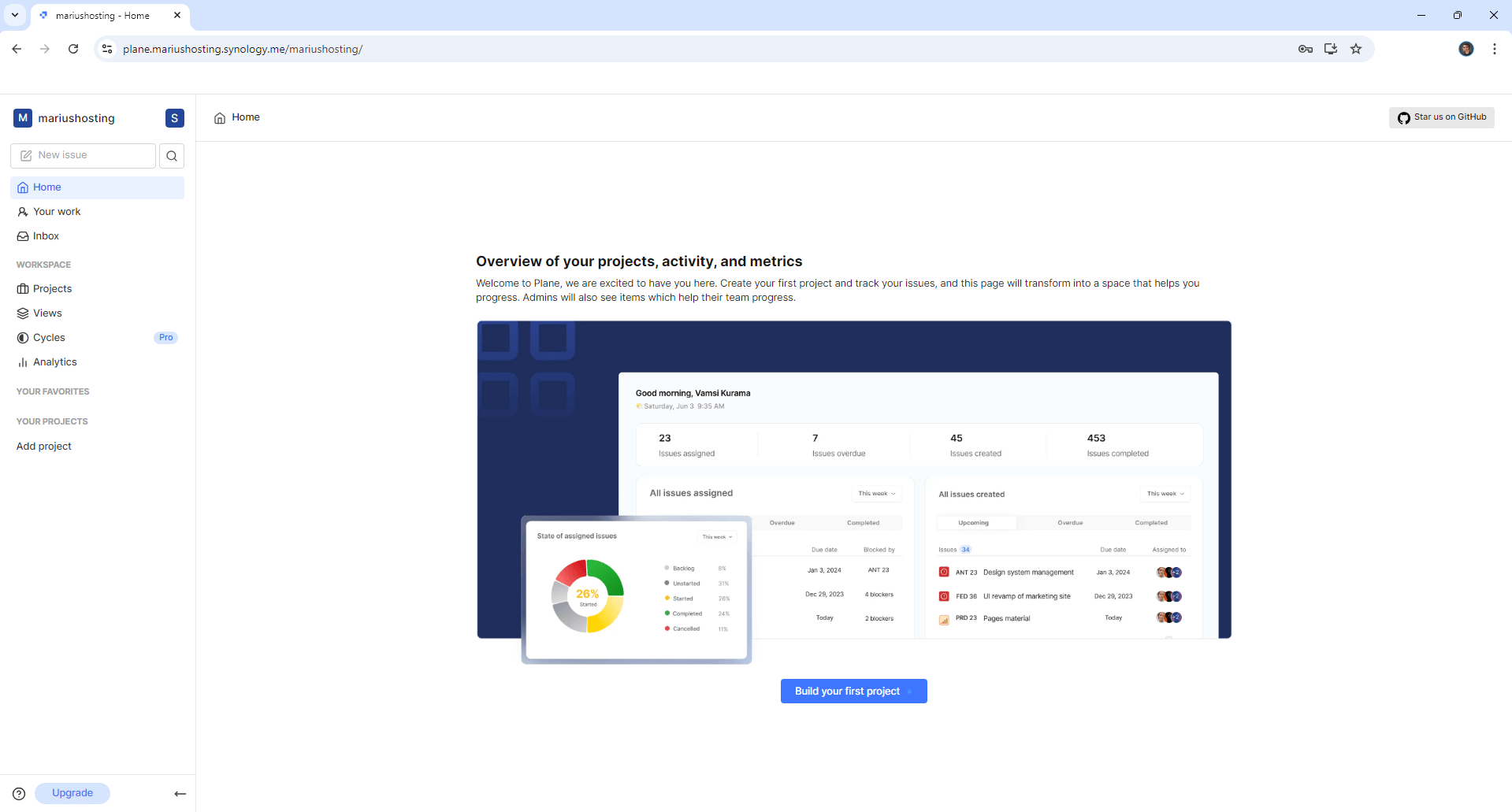
STEP 30
At the top left of the page click on your Profile icon then Settings. Follow the instructions in the image below.
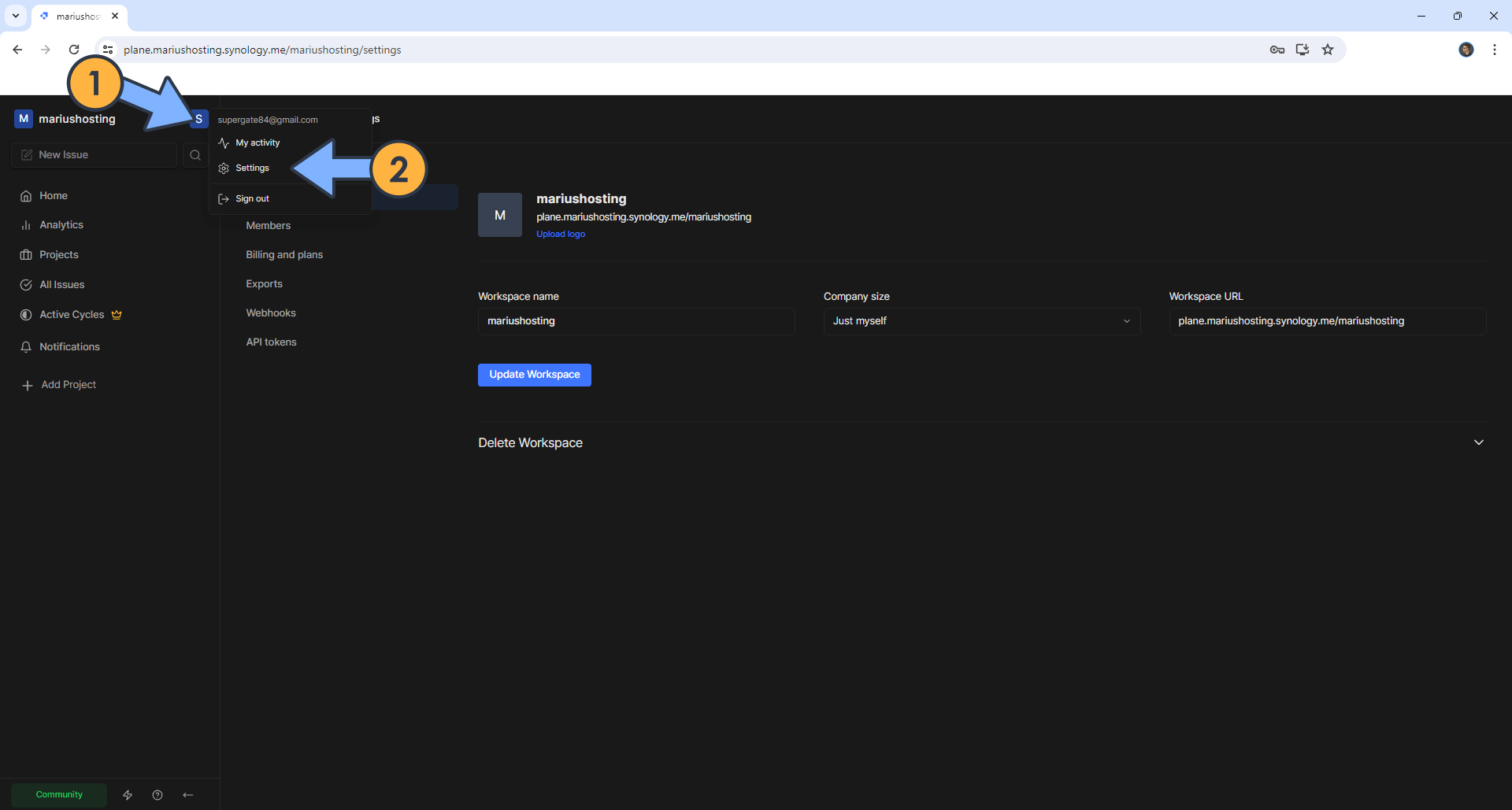
STEP 31
On the left sidebar click Preferences, then change your theme to Dark from the dropdown menu. Follow the instructions in the image below.
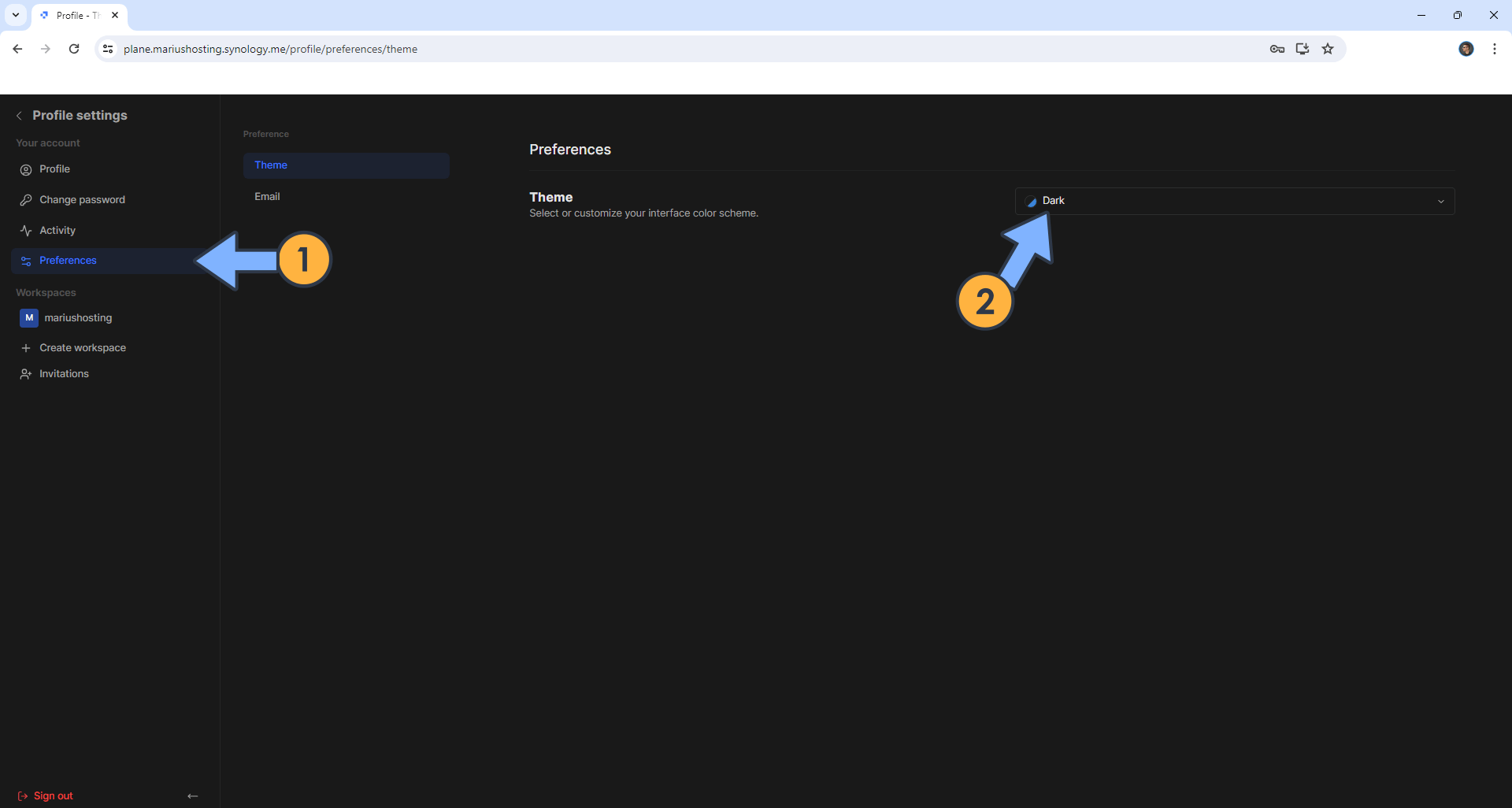
STEP 32
Your Plane dashboard at a glance!
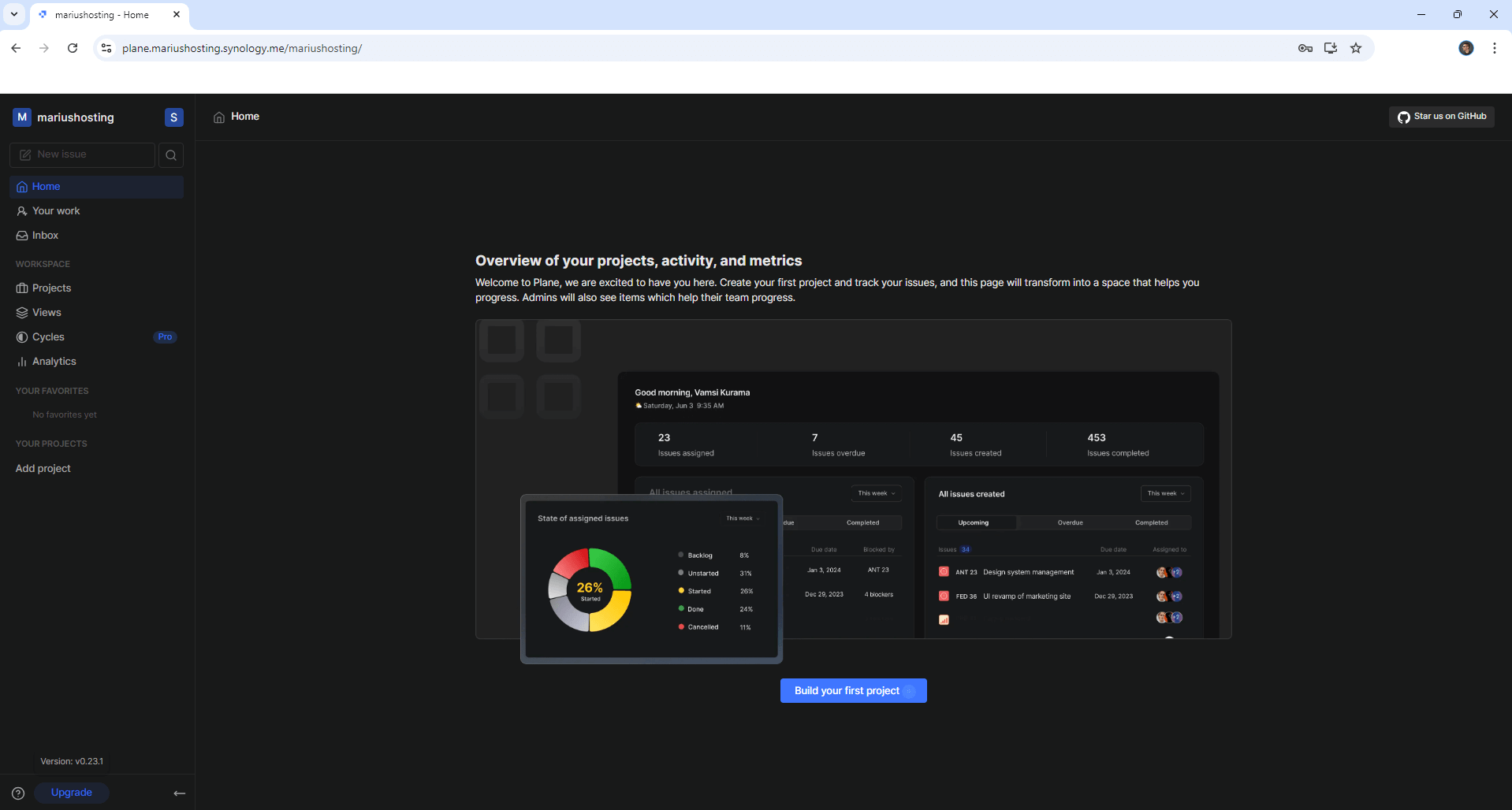
Enjoy Plane!
If you encounter issues by using this container, make sure to check out the Common Docker issues article.
Note: Can I run Docker on my Synology NAS? See the supported models.
Note: How to Back Up Docker Containers on your Synology NAS.
Note: Find out how to update the Plane container with the latest image.
Note: How to Free Disk Space on Your NAS if You Run Docker.
Note: How to Schedule Start & Stop For Docker Containers.
Note: How to Activate Email Notifications.
Note: How to Add Access Control Profile on Your NAS.
Note: How to Change Docker Containers Restart Policy.
Note: How to Use Docker Containers With VPN.
Note: Convert Docker Run Into Docker Compose.
Note: How to Clean Docker.
Note: How to Clean Docker Automatically.
Note: Best Practices When Using Docker and DDNS.
Note: Some Docker Containers Need WebSocket.
Note: Find out the Best NAS Models For Docker.
Note: Activate Gmail SMTP For Docker Containers.
This post was updated on Tuesday / June 10th, 2025 at 2:22 PM
